Truck Loading and Unloading Conveyor
Loading conveyor systems revolutionize logistics operations by significantly reducing manual labor while dramatically improving loading efficiency.
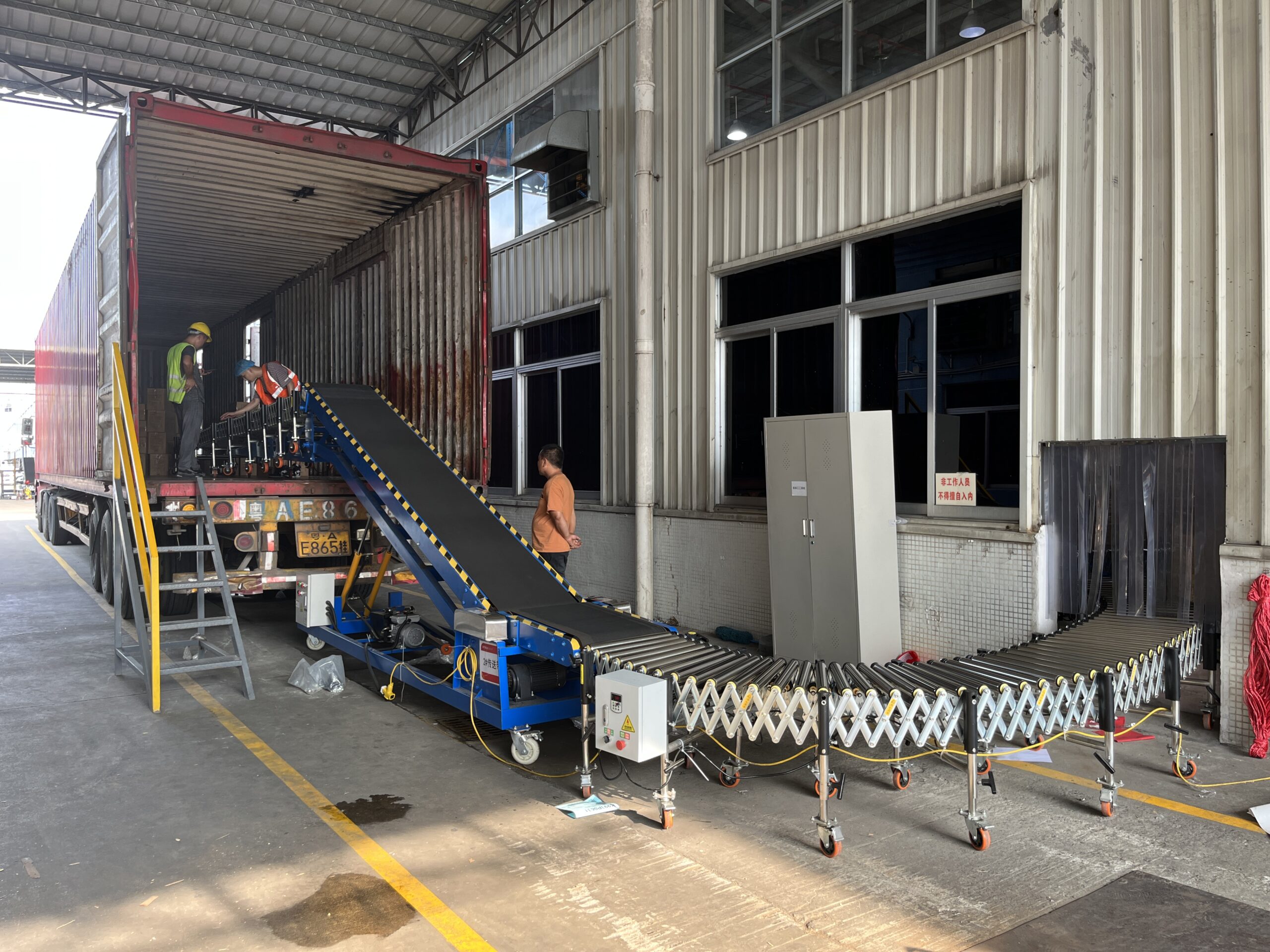
Loading conveyor systems revolutionize logistics operations by significantly reducing manual labor while dramatically improving loading efficiency. These versatile systems are designed to handle both loading and unloading operations, as the conveyors support bidirectional movement. By implementing an advanced truck loading conveyor, businesses can achieve operational excellence through streamlined processes, reduced workforce requirements, and accelerated turnover times.

Modern container loading conveyor solutions offer robust mechanisms that minimize physical strain on workers while maximizing throughput capacity. The return on investment becomes evident through increased productivity, reduced labor costs, and enhanced workplace safety.
Types of Loading Conveyor Systems
The selection of an appropriate truck loading and unloading conveyor system depends primarily on infrastructure availability and specific cargo requirements. Below we explore various configurations designed for different operational environments.
Loading Conveyor Systems with Loading Dock
When a loading dock is available, the ground level can be aligned with the container or truck bed height, eliminating the need for a Hydraulic Conveyor to transport goods from ground level up an incline to the container/truck bed height.

Telescopic Belt Conveyor
The telescopic belt conveyor represents the pinnacle of efficiency for truck loading and unloading operations. This sophisticated system delivers exceptional performance across diverse cargo types, making it the preferred choice for large-scale logistics and freight operations handling 20-foot containers and beyond.

Key Benefits:
- Exceptional efficiency rates
- Versatility with any cargo type
- Extendable reach for deep container access
- Customizable fixed and telescopic section lengths
Configuration Options:
- Hydraulic lift for height adjustment
- Operator platform for ergonomic handling
- Hump feature for specialized cargo routing
- Electric casters for powered mobility
- Manual casters for flexible positioning
- Piece counter for inventory management
- Top sweep functionality
- Rear-end ramp (ideal for facilities without a loading dock)
Technical Specifications (TeleScopic Conveyor – 4 Sections):
- Conveying Speed: 10-40 m/min (frequency adjustable)
- Rated Load: ≤ 80 kg/m²
- Motor: Conveying motor (2.2 kW), Telescoping motor (0.75 kW)
- Belt: 3 mm PVK impact-resistant composite belt
- Dimensions: Various configurations available (5000-8000 mm fixed section)
- Extended Length: Up to 17000 mm
- Equipment Weight: 2.1-3.0 tons
| Fixed Section (mm) | Max Extension (mm) | Height (mm) | Equipment Weight (t) |
| 5000 | 9000 | ≥ 760 | 2.1 |
| 6000 | 12000 | ≥ 760 | 2.4 |
| 7000 | 14000 | ≥ 760 | 2.7 |
| 8000 | 17000 | ≥ 760 | 3.0 |
Powered Roller Conveyor – Multi-wedge Belt Driven
Powered Roller Conveyor – Multi-wedge Belt Driven is ideal for heavier flat cargo such as boxed beverages, barreled water, large flat-bottomed cardboard boxes, and lightweight bagged goods under 20kg. This robust conveyor system achieves a load capacity of 80kg/m, making it suitable for demanding logistics environments.

Technical Specifications (2000 mm/Section):
- Speed: 40 m/min
- Collapsed Length: 700 mm
- Extended Length: 2000 mm
- Load Capacity: 100 kg/m
- Available Widths: 500/600/800 mm
- Roller Diameter: 50 mm
- Extension Ratio: 2:3
Powered Roller Conveyor – O-shaped Belt Driven
Powered Roller Conveyor – O-shaped Belt Driven is perfect for lighter flat cargo including courier company’s cardboard packages and lightweight bagged goods under 20kg. This system provides a load capacity of 80kg/m with excellent reliability for continuous operations.

Technical Specifications (1500 mm/Section):
- Speed: 40 m/min
- Collapsed Length: 525 mm
- Extended Length: 1500 mm
- Load Capacity: 80 kg/m
- Available Widths: 500/600/800 mm
- Roller Diameter: 50 mm
- Extension Ratio: 1:3
Powered Rubber Roller Conveyor – Multi-wedge Belt Driven
Engineered for heavy-duty applications handling both bagged goods and flat-bottomed items without slippage. With an impressive load capacity of 120kg/m, this conveyor is particularly suited for logistics companies specializing in oversized parcels.
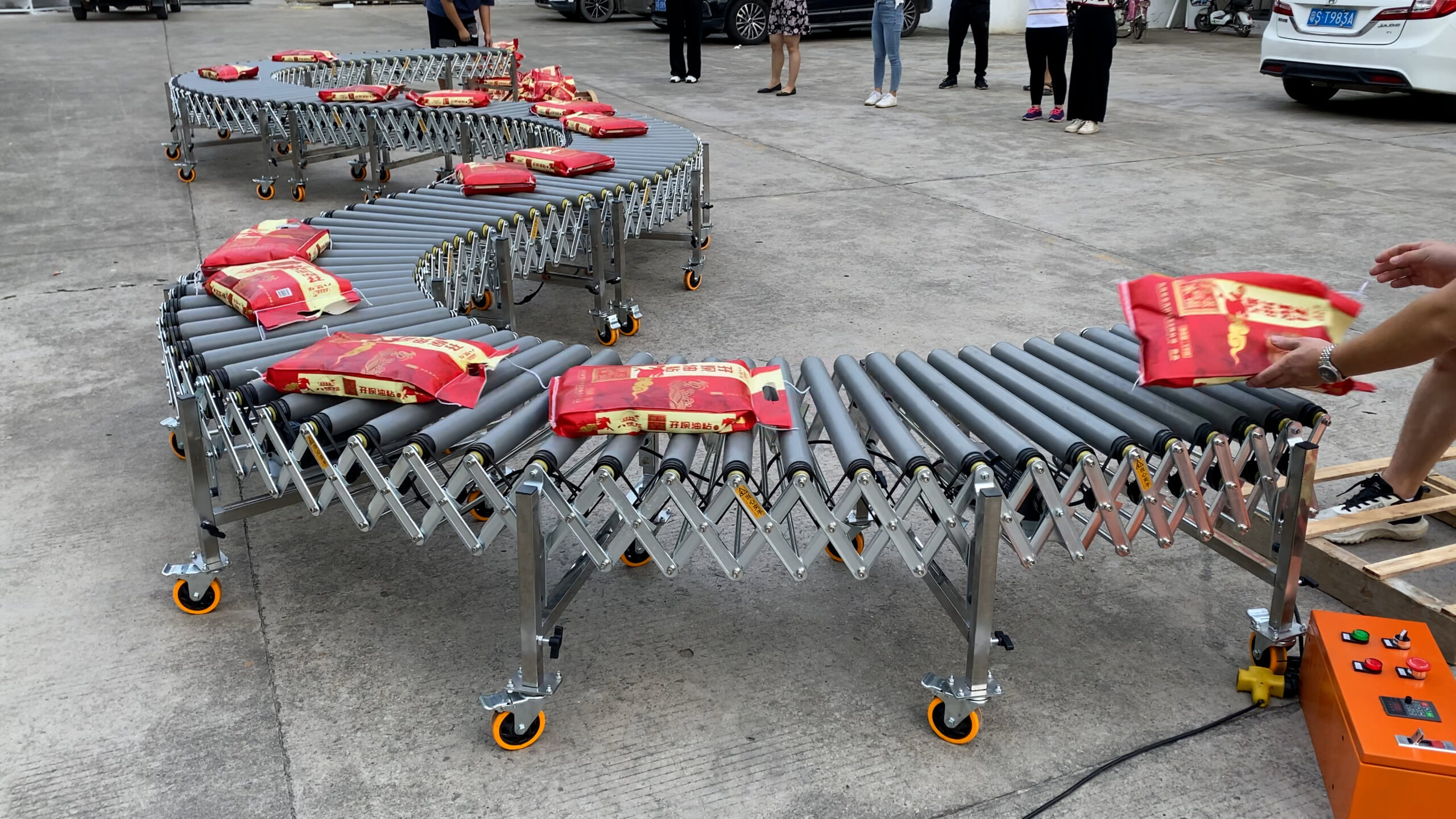
Technical Specifications (1100 mm/Section):
- Overall Machine Length: Collapsed: 560 mm, Extended: 1100 mm
- Extension Ratio: 1:3
- Load Capacity: 120 kg/m
- Speed: 40 m/min
- Available Widths: 500/600/800 mm
- Roller Diameter: 54 mm
Loading Conveyor Systems without Loading Dock
Without a loading dock, Hydraulic Conveyors become essential to transport goods from ground level via an incline to the container/truck bed height. Alternatively, a Telescopic Conveyor with a hydraulic ramp at the tail end can be elevated using a steel frame to container/truck bed height. These configurations represent versatile portable truck loading conveyor solutions suitable for various applications.
Hydraulic Conveyor – Large with Powered Roller Conveyor
This highly versatile container loading conveyor system creates an incline to transport goods from ground level (700mm) to a height of 2400mm. The top front section can accommodate a Powered Roller Conveyor that extends into the container interior for efficient cargo movement.

Key Features:
- Suitable for any container and truck loading/unloading
- Hydraulic adjustment for the lower platform
- Portable design for flexible deployment
- Maximum container penetration of 12000mm
Technical Specifications:
- Speed: 30 m/min
- Overall Machine Length: 7900 mm
- Load Capacity: 80 kg/m
- Available Widths: 600/800 mm
- Belt Material: PVC 5.0mm Black Grass Pattern Anti-Slip Belt
Standard Bracket Capacity:
| Conveyor Type | Sections | Maximum Extension |
| Skate Wheel Conveyor | 9 Sections | 18900 mm |
| 38 mm Gravity Roller Conveyor | 7 Sections | 13600 mm |
| 50 mm Gravity Roller Conveyor | 8 Sections | 12000 mm |
| 2000 mm Powered Roller Conveyor | 5 Sections | 10000 mm |
| 1500 mm Powered Roller Conveyor | 8 Sections | 12000 mm |
| 1100 mm Powered Rubber Roller Conveyor | 7 Sections | 7700 mm |
Hydraulic Conveyor – Medium with Powered Roller Conveyor
Creates an incline to transport goods from ground level (700mm) to a height of 2400mm. The top front section accommodates a Powered Roller Conveyor that extends into the container for efficient cargo handling.
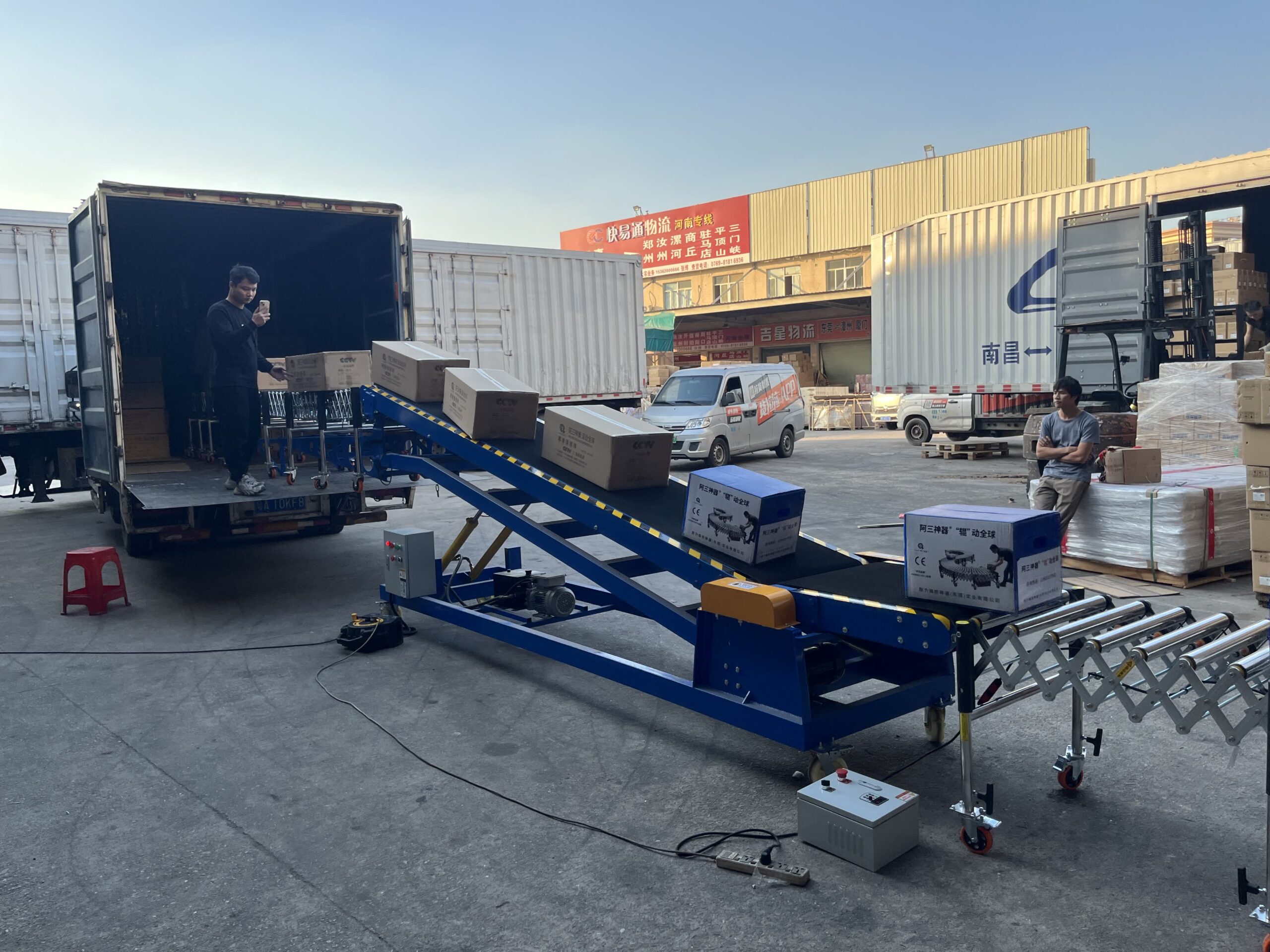
Key Features:
- Suitable for any container and truck loading/unloading
- Maximum container penetration of 10 meters
- Fixed lower platform height (no hydraulic adjustment)
Technical Specifications:
- Speed: 30 m/min
- Overall Machine Length: 7000 mm
- Load Capacity: 80 kg/m
- Available Widths: 600/800 mm
Standard Bracket Capacity:
| Conveyor Type | Sections | Maximum Extension |
| Skate Wheel Conveyor | 5 Sections | 10500 mm |
| 38 mm Gravity Roller Conveyor | 4 Sections | 6800 mm |
| 50 mm Gravity Roller Conveyor | 3 Sections | 4500 mm |
| 2000 mm Powered Roller Conveyor | 3 Sections | 6000 mm |
| 1500 mm Powered Roller Conveyor | 4 Sections | 6000 mm |
| 1100 mm Powered Rubber Roller Conveyor | 4 Sections | 4400 mm |
Extended Bracket Capacity:
| Conveyor Type | Sections | Maximum Extension |
| Skate Wheel Conveyor | 6 Sections | 12600 mm |
| 38 mm Gravity Roller Conveyor | 6 Sections | 10200 mm |
| 50 mm Gravity Roller Conveyor | 4 Sections | 6000 mm |
| 2000 mm Powered Roller Conveyor | 5 Sections | 10000 mm |
| 1500 mm Powered Roller Conveyor | 5 Sections | 7500 mm |
| 1100 mm Powered Rubber Roller Conveyor | 5 Sections | 5500 mm |
Hydraulic Conveyor – Small with Powered Roller Conveyor
Creates an incline to transport goods from ground level (700mm) to a height of 1820mm. The top front section accommodates a Powered Roller Conveyor extending into the truck for efficient cargo transfer.

Key Features:
- Maximum penetration of approximately 6 meters
- Suitable for trucks with cargo space depths under 7.2 meters
- Non-adjustable lower platform height
Technical Specifications:
- Speed: 30 m/min
- Overall Machine Length: 4000 mm
- Load Capacity: 80 kg/m
- Available Widths: 600/800 mm
Standard Bracket Capacity:
| Conveyor Type | Sections | Maximum Extension |
| Skate Wheel Conveyor | 5 Sections | 10500 mm |
| 38 mm Gravity Roller Conveyor | 4 Sections | 6800 mm |
| 50 mm Gravity Roller Conveyor | 3 Sections | 4500 mm |
| 2000 mm Powered Roller Conveyor | 3 Sections | 6000 mm |
| 1500 mm Powered Roller Conveyor | 4 Sections | 6000 mm |
| 1100 mm Powered Rubber Roller Conveyor | 4 Sections | 4400 mm |
Hydraulic Conveyor – Micro
Creates an incline to transport goods from ground level (700mm) to a height of 1700mm. This compact model features a shorter upper platform without brackets for Powered Roller Conveyor installation, making it ideal for small truck loading and unloading operations.
Technical Specifications:
- Speed: 30 m/min
- Overall Machine Length: 3700 mm
- Load Capacity: 50 kg/m
- Available Widths: 600/800 mm
Telescopic Belt Conveyor with Hydraulic Lower Platform
Telescopic belt conveyors offer numerous optional configurations, including hydraulic lower platforms and elevated frames, enabling them to function similarly to Hydraulic Conveyors by transporting goods up an incline to truck bed height.
As a comprehensive truck loading belt conveyor solution, larger logistics companies often prioritize these more stable and efficient loading conveyor systems, even without dedicated loading docks.
Selecting the Appropriate Truck Loading and Unloading Conveyor System
As experienced truck loading conveyor manufacturers, we can provide suitable loading and unloading conveyor solutions for various industries and applications based on specific requirements.
Key Considerations for System Selection
1. Loading Dock Availability
The presence or absence of a loading dock fundamentally determines the type of system required. With a loading dock, the focus shifts to telescopic and powered roller systems. Without a loading dock, hydraulic solutions become essential to bridge the height gap.

2. Cargo Characteristics
Understanding your cargo profile is critical for selecting the optimal conveyor system:
| Cargo Type | Weight | Recommended Conveyor System |
| Bagged Goods (Heavy) | >20kg | Powered Rubber Roller Conveyor |
| Bagged Goods (Light) | <20kg | Powered Roller Conveyor |
| Cardboard Boxes (Flat Bottom) | Various | Telescopic Belt Conveyor / Powered Roller Conveyor |
| Irregular Shapes | Various | Telescopic Belt Conveyor |
| Basket/Crate Packaged | Various | Roller Conveyor (Based on bottom surface) |
Additional cargo considerations include:
- Dimensions and uniformity
- Surface characteristics (smooth, rough, irregular)
- Fragility and handling requirements
- Usage frequency and volume throughput
3. Available Space for the Conveyor System

Different truck loading conveyors require varying spatial accommodations, though many systems offer folding capabilities for compact storage. When evaluating space requirements, consider:
- Operational footprint during usage
- Storage footprint when not in use
- Clearance requirements for extension and retraction
- Access pathways for maintenance
4. Truck/Container Specifications
Whether using a Hydraulic Conveyor, Telescopic Conveyor, or Powered Roller Conveyor with a loading dock, we tailor recommendations based on the largest container dimensions to ensure the most suitable and economical loading/unloading conveyor solution.

Key truck/container considerations include:
- Interior dimensions (length, width, height)
- Door opening dimensions
- Floor height from ground level
- Special interior features (tie-downs, tracks, etc.)
5. Environmental Conditions
For humid or wet environments, we recommend critical components constructed from 201 stainless steel rather than standard galvanized steel to ensure longevity and reliable performance.
Other environmental factors to consider:
- Temperature extremes
- Exposure to chemicals or corrosive substances
- Dust or particulate matter
- Indoor vs. outdoor operation
6. Electrical Requirements
We generally recommend three-phase power supply. Our standard conveyor products operate on three-phase 380V, but we can accommodate different voltage requirements with advance notification.
Power considerations include:
- Voltage availability and stability
- Phase configuration
- Current capacity
- Backup power requirements
7. Warehouse-to-Loading Area Transportation Needs
We can provide comprehensive solutions spanning from warehouse to truck/container, creating an integrated material handling ecosystem.
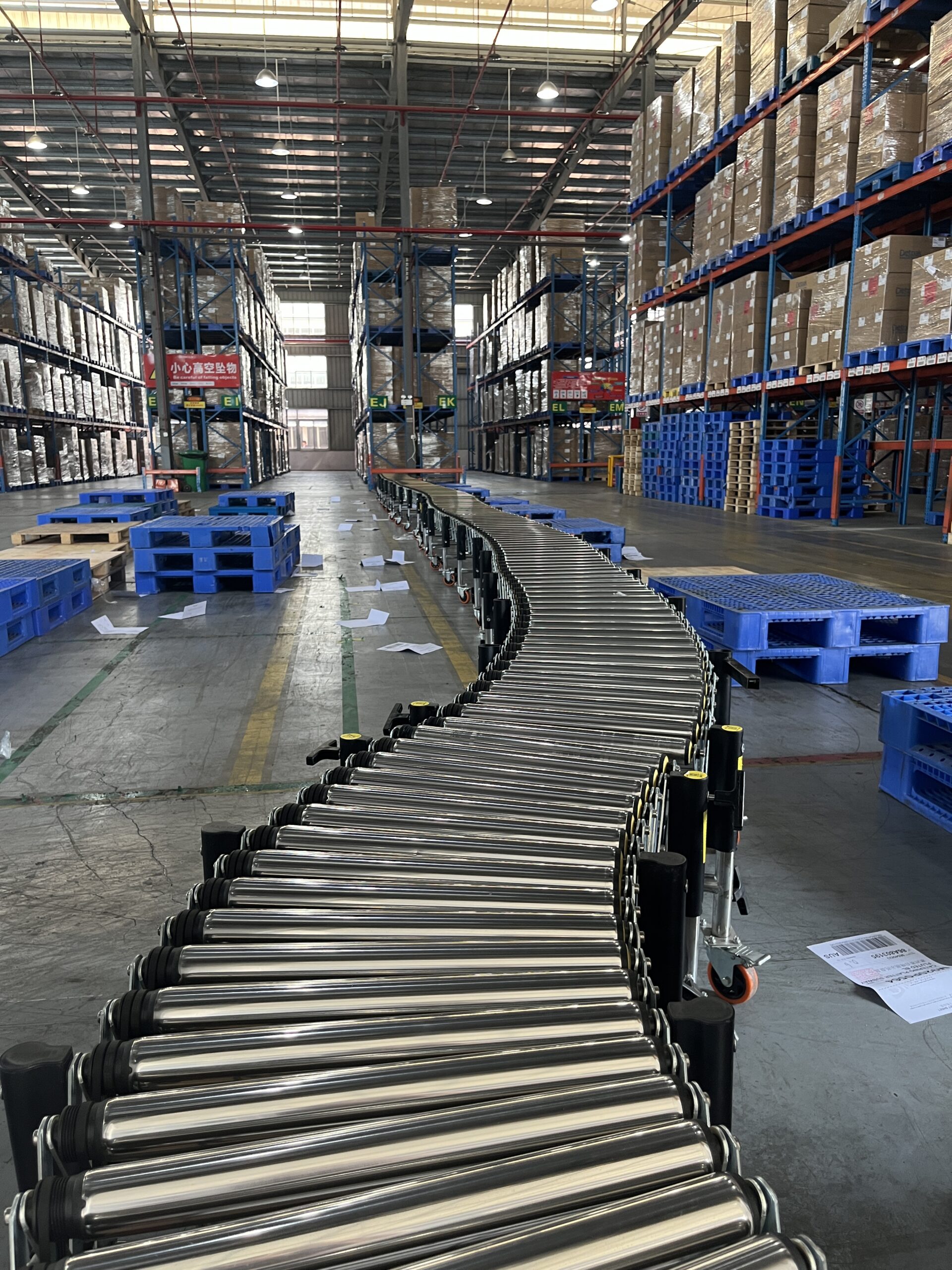
Comprehensive system elements may include:
- Sorting systems
- Accumulation zones
- Directional control mechanisms
- Integration with warehouse management systems
- Scanning and tracking capabilities
Beyond Manual Labor: The Evolution of Truck Loading Efficiency
Gone are the days when loading and unloading trucks relied solely on human muscle power. The implementation of specialized truck loading conveyor systems has revolutionized warehouse operations, dramatically reducing physical strain while significantly improving throughput capacity. These purpose-built machines directly replace the most physically demanding aspects of logistics operations.
A logistics manager with 20+ years of experience put it simply: “What used to require six people breaking their backs can now be accomplished by two workers in half the time. Our portable truck loading conveyor doesn’t just move boxes – it’s eliminated the physical burden that was driving away good employees.”
The Physical Toll of Manual Loading

Without mechanical assistance, the typical container unloading process is grueling. Workers must:
- Repeatedly enter and exit the container
- Manually carry heavy packages the entire length of the container
- Perform thousands of lifting motions per shift
- Maintain productivity regardless of heat, fatigue or container depth
This approach takes a devastating toll on worker health. According to industry safety data, workers engaged in manual loading operations experience back injuries at nearly three times the rate of other warehouse positions. These injuries lead to lost work days, compensation claims, and talent retention challenges that affect the entire operation.
Direct Replacement of Physical Effort
The primary function of container loading conveyor systems is straightforward – they directly replace human carrying capacity with mechanical movement. This replacement yields immediate, measurable benefits:
Labor Reduction Manual unloading of a standard 40-foot container typically requires 4-6 workers forming a human chain. With a truck loading and unloading conveyor, this same task requires just 1-2 workers – one positioning items on the conveyor, one arranging them at the destination.
Time Efficiency Consider this comparison from a regional distribution center:
| Loading Method | Workers Required | Time to Unload 40′ Container | Labor Hours Per Container |
|---|---|---|---|
| Manual Process | 6 | 4.5 hours | 27 |
| With Truck Loading Conveyor | 2 | 1.5 hours | 3 |
| Improvement | 67% reduction | 67% reduction | 89% reduction |
The dramatic reduction in labor hours represents direct cost savings while enabling faster processing of incoming shipments.
Sustained Productivity Human workers naturally fatigue over time, particularly when performing physically demanding tasks. Productivity typically declines significantly in the later hours of a shift. Mechanical conveyor systems maintain consistent throughput regardless of operational duration, eliminating the afternoon productivity slump that plagues manual operations.
One distribution center supervisor noted: “With manual unloading, we’d see a 30-40% slowdown in the afternoon as fatigue set in. Our portable truck loading conveyor maintains the same speed hour after hour, day after day.”
Practical Applications Across Industries
The labor replacement value of loading conveyor systems translates across virtually every industry that handles boxed, bagged, or case goods. Let’s examine how different sectors have applied this technology to solve specific operational challenges.
Retail Distribution Transformed
A major retail chain was struggling with container unloading at their main distribution center. The manual process created a bottleneck that affected the entire supply chain. After analyzing their operation, they implemented truck loading belt conveyors at their primary receiving docks.
The results were immediate and dramatic. Container unloading time decreased from 4+ hours to approximately 75 minutes. The required workforce reduced from six to two people per container. Perhaps most importantly, the physical burden on workers was essentially eliminated.
“Before we installed the conveyor system, unloading containers was our least popular assignment,” the warehouse manager explained. “Now it’s no longer seen as punishment duty because the physical strain is gone. Our workers focus on proper product handling rather than simply surviving the shift.”
Construction Supply Challenge Solved
Loading heavy construction materials presents unique challenges. A building materials supplier was struggling with the manual loading of 50kg cement bags and other heavy items into delivery trucks. The process was slow, dangerous, and limited their ability to utilize older workers with valuable experience.
Their solution combined a hydraulic conveyor for elevation with powered rubber roller conveyors extending into trucks. This truck loading and unloading conveyor system completely eliminated manual carrying of heavy bags.
Workers now simply place bags on the conveyor at ground level. The hydraulic section elevates them to truck height, and the powered rollers deliver them deep into the truck where a single worker arranges them. The physical requirement has shifted from strength to judgment – properly organizing loads rather than carrying heavy items.
The impact on worker health was immediate. Back injuries, previously a common occurrence, were virtually eliminated. The company was also able to retain experienced workers who could no longer handle the physical demands of manual loading but possessed valuable knowledge about products and loading patterns.
Food Distribution Efficiency Boost
A regional food distributor needed to accelerate their truck loading process without expanding their facility. Their manual approach using hand trucks and human chains was creating a bottleneck that limited daily delivery capacity.
They implemented powered roller conveyors with extending capability to reach deep into trucks. The system allowed direct movement of cases from the picking area to the interior of delivery vehicles without manual carrying.
The results transformed their operation:
- Loading time decreased by 60%
- Labor requirements reduced from 3 workers to 1 per truck
- Daily delivery capacity increased by 40%
- Physical strain on workers virtually eliminated
“We’re essentially doing the same work with one-third the labor and in half the time,” their operations director reported. “The truck loading belt conveyor paid for itself in under a year just through direct labor savings, not even counting the increased delivery capacity.”
Physical Impact: What Workers Experience
The transition from manual to conveyor-assisted loading creates a fundamental shift in the physical experience of warehouse workers. Consider the typical manual unloading process for a 40-foot container:
A worker might make 30-40 trips into and out of the container Each trip requires carrying 15-20kg packages 10-15 meters By shift end, workers have typically walked 3-5 miles while carrying loads The cumulative lifting total often exceeds several tons per worker
This physical burden manifests in multiple ways:
Immediate fatigue and reduced capacity as the shift progresses Cumulative strain leading to chronic musculoskeletal issues Increased risk of acute injuries from lifting, twisting, and carrying Heat stress and dehydration, especially in warmer months General physical exhaustion that affects off-work recovery and quality of life
When a truck loading conveyor replaces this manual effort, the physical experience transforms dramatically. Workers now:
Remain primarily in one position, either placing items on the conveyor or receiving them Lift items only once rather than carrying them long distances Experience minimal walking and no crawling inside containers Avoid the cumulative fatigue that comes from thousands of carrying motions Maintain consistent energy levels throughout their shift
One warehouse worker described the difference: “It’s night and day. I used to be completely wiped out after unloading containers. I’d go home, take pain relievers, and collapse on the couch. Now I finish my shift with energy to spare. I can actually have a life outside of work because I’m not physically destroyed every day.”
This transformation extends beyond comfort to measurable health impacts. Companies consistently report:
70-85% reduction in back injuries after implementing loading conveyors Significant decrease in repetitive strain conditions Lower turnover in loading/unloading positions Extended working careers for experienced employees Reduced absenteeism related to physical recovery
The safety manager at a major distribution center noted: “We tracked injury rates before and after installing our truck loading and unloading conveyor. Back injuries decreased by 78% in the first year. Workers’ comp claims related to loading dropped by over 80%. These aren’t small improvements – they represent a fundamental change in the physical demands of the job.”
Economic Reality: The Numbers Behind Labor Replacement
While the health benefits are compelling, the economic case for truck loading conveyor systems is equally strong. The direct replacement of manual labor with mechanical assistance creates immediate financial impact through multiple channels.
Most operations measure success through several key metrics:
Direct Labor Savings
A typical container unloading operation provides a clear example:
Manual unloading: 6 workers × 4.5 hours = 27 labor hours per container Conveyor unloading: 2 workers × 1.5 hours = 3 labor hours per container Net reduction: 24 labor hours per container
For an operation unloading 10 containers weekly at a fully-burdened labor rate of $25/hour, this represents: 24 hours × 10 containers × $25 = $6,000 weekly labor savings Annual savings: approximately $312,000
Injury Reduction Value
The average direct cost of a back injury in warehouse settings ranges from $9,000 to $24,000 per incident. Indirect costs (including replacement labor, reduced productivity, and administrative time) typically add another 2-4× this amount.
For a medium-sized operation experiencing 6-8 loading-related injuries annually, the potential savings from an 80% reduction in incidents can reach $150,000-$500,000 per year.
Throughput Improvement
Many operations find the increased capacity represents the greatest economic value. When loading/unloading time decreases by 60-70%, the operation can process more shipments with the same dock facilities.
A distribution center that increases daily container processing from 8 to 14 containers without facility expansion gains enormous operational leverage. This throughput improvement often represents the difference between requiring facility expansion and maximizing existing resources.
Equipment Investment Reality
Against these substantial benefits, the investment in truck loading and unloading conveyor equipment is relatively modest. A quality extendable truck loading conveyor typically represents an investment of $5,000-$20,000 depending on size, features and capacity.
With annual savings often exceeding $300,000 for medium-sized operations, the return on investment is both rapid and substantial. Most operations achieve complete payback within 3-6 months based solely on direct labor savings.
When factoring in injury reduction, throughput improvements, and worker retention benefits, the economic case becomes overwhelming. As one operations director put it: “This isn’t just a good investment – it’s operational malpractice not to implement these systems if you’re still using purely manual loading methods.”
Maintenance Simplicity Keeps Systems Running
A key advantage of truck loading conveyor systems over more complex automation is their mechanical simplicity and maintenance accessibility. These systems are designed for reliable operation with minimal specialized maintenance.
For extendable container loading conveyors, routine maintenance typically includes:
Daily visual checks – A simple walk-around inspection before operation to identify any visible issues with the belt, rollers, or extending mechanism.
Weekly attention to belt tracking and tension. This basic adjustment ensures the belt remains properly centered and maintains appropriate tension for effective operation.
Monthly lubrication of extending tracks and moving components. Most systems feature easily accessible grease points that require minimal time to maintain.
Quarterly electrical inspection of motors, controls and safety systems. This preventive check helps identify potential issues before they cause operational disruptions.
Most maintenance tasks can be performed by general maintenance staff without specialized training. The systems are designed with accessibility in mind, with major components easily reached for inspection or replacement.
Hydraulic conveyor systems require similar attention with additional focus on the hydraulic system:
Regular fluid level checks Inspection of hoses and connections for leaks Periodic hydraulic filter replacement Pressure testing to ensure optimal performance
The overall maintenance burden is remarkably light compared to the operational benefits. Most systems require less than 2 hours of maintenance attention monthly, representing a minimal operational impact.
As one maintenance manager observed: “These are easily the lowest-maintenance pieces of equipment in our warehouse. The design is straightforward, the components robust, and the adjustment points accessible. We spend maybe an hour a month keeping our container loading conveyor in top condition.”
Questions Buyers Ask About Labor Replacement
When considering truck loading conveyor systems specifically for labor replacement, potential buyers frequently ask practical questions about implementation and operations:
“How quickly will we see results?”
Labor replacement benefits begin immediately upon implementation. From the first day of operation, you’ll require fewer workers to accomplish the same loading/unloading tasks. Most operations report 50-70% labor reduction from day one, with efficiency continuing to improve as operators become more familiar with the system.
“What happens if the conveyor breaks down?”
Quality truck loading conveyor systems are designed for reliability, with breakdown rates significantly lower than most warehouse equipment. In the rare event of mechanical issues, most problems can be quickly diagnosed and repaired. For critical operations, many facilities maintain basic spare parts (belts, rollers, etc.) for immediate repairs.
Even in worst-case scenarios, operations can temporarily revert to manual methods if absolutely necessary. However, with proper maintenance, significant downtime is extremely rare.
“Will our workers resist the new equipment?”
Rather than resistance, most operations report enthusiastic worker acceptance of loading conveyor systems. The physical relief provided is immediately apparent, and most workers quickly appreciate eliminating the most physically demanding aspects of their job.
As one HR director noted: “We were prepared for resistance to change, but it never materialized. On the first day, when workers realized they wouldn’t be carrying boxes the length of the container anymore, we had immediate buy-in. Now they wonder how they ever managed the old way.”
“Can we move the equipment between loading areas?”
Most truck loading and unloading conveyor systems offer excellent portability. Systems equipped with heavy-duty casters can be readily moved between dock doors or loading areas. This flexibility allows facilities to deploy their conveyor assets where they’re most needed on any given day.

The extendable design also accommodates different vehicle lengths and loading requirements, making these systems highly adaptable to changing operational needs.
“What about unique or fragile products?”
Conveyor systems offer greater control over product handling than manual carrying. Speed can be adjusted to accommodate fragile items, and smooth transitions between conveyor sections minimize jostling and impact. Many operations report reduced product damage after implementing conveyor systems precisely because items receive more consistent, controlled handling.
Making the Transition: Implementation Simplicity
Unlike complex warehouse automation projects that may require months of planning and installation, truck loading conveyor implementation is remarkably straightforward. The transition from manual methods typically follows this simple process:
- Site assessment – Evaluating your specific loading/unloading requirements, including:
- Typical container or truck types
- Product characteristics (size, weight, fragility)
- Available space and power supply
- With or without loading dock
- System selection – Choosing the appropriate conveyor type:
- Extendable truck loading conveyor for deep-reach container access
- Hydraulic conveyor for ground-to-truck transition without a dock
- Powered roller conveyor for specialized cargo types
- Minimal site preparation – Typically limited to:
- Ensuring adequate three-phase power availability
- Clearing sufficient operational space
- Confirming floor surface adequacy
- Rapid installation – Most systems are operational within 1-2 days of delivery, requiring:
- Initial positioning
- Power connection
- Basic operational adjustments
- Brief operator training
- Immediate operation – The simplicity of these systems allows for productive use immediately after installation, with minimal learning curve.
The non-disruptive nature of this implementation process means most facilities can transition without operational downtime. Many companies install their systems during weekend periods and begin full operation on Monday morning.
“We were amazed by how quick and simple the implementation was,” reported the operations manager at a furniture distribution center. “The portable truck loading conveyor arrived on Tuesday, was operational by Wednesday afternoon, and by Thursday morning our team was working at twice their previous pace with half the people. There was no complex integration or extended learning curve – just immediate productivity improvement.”
The Human Element: Redeploying Labor for Greater Value
Perhaps the most overlooked benefit of truck loading conveyor systems is how they allow organizations to redirect human effort from pure physical labor to higher-value activities. Rather than eliminating jobs, most operations find themselves redeploying workers to tasks that better utilize human capabilities.
When workers are freed from the physical burden of carrying packages, they can focus on:
Quality control – Inspecting products during loading/unloading to identify damage or issues Proper stacking – Ensuring optimal load arrangement for stability and space utilization Inventory verification – Confirming shipment contents against documentation Customer-specific requirements – Implementing special handling or organization requests
These value-added activities improve overall operation quality while providing more engaging work for employees. The transformation often shifts loading/unloading from “necessary physical labor” to skilled positions that contribute more meaningfully to operational excellence.
One distribution center manager shared this perspective: “Before our truck loading and unloading conveyor, we were essentially paying people to be human mules, carrying boxes back and forth. Now those same employees contribute their experience and judgment to ensuring proper handling, organization, and verification. The physical transport happens automatically, letting humans do what humans do best – apply intelligence and care to the process.”
This evolution represents the true promise of appropriate technology application – not replacing humans entirely, but eliminating the physically damaging aspects of work while elevating the human contribution to higher-value activities.
Conclusion: The Simple Power of Labor Replacement
In an era of increasingly complex warehouse automation, truck loading conveyor systems represent a refreshingly straightforward approach to improving operations. Rather than requiring wholesale operational changes or complex integration, these systems directly address one of the most persistent challenges in logistics – the physical burden of moving goods between storage and transportation.
By focusing specifically on this critical transition point, container loading conveyor systems deliver immediate, measurable benefits without disrupting broader warehouse operations. The labor replacement value is clear and compelling:
The most physically demanding aspects of loading/unloading are eliminated Labor requirements typically decrease by 50-70% Worker health and longevity improve dramatically Throughput capacity increases without facility expansion Return on investment is rapid and substantial
For organizations still relying on predominantly manual loading methods, implementing appropriate conveyor technology represents one of the clearest opportunities for operational improvement available today. The technology is proven, the implementation straightforward, and the benefits immediate.
Whether you require an extendable truck loading conveyor for deep container access, a hydraulic conveyor for dock-less operations, or powered roller conveyors for specialized cargo, the fundamental value proposition remains constant – replacing human physical effort with reliable mechanical movement, freeing workers to contribute their uniquely human capabilities to your operation.
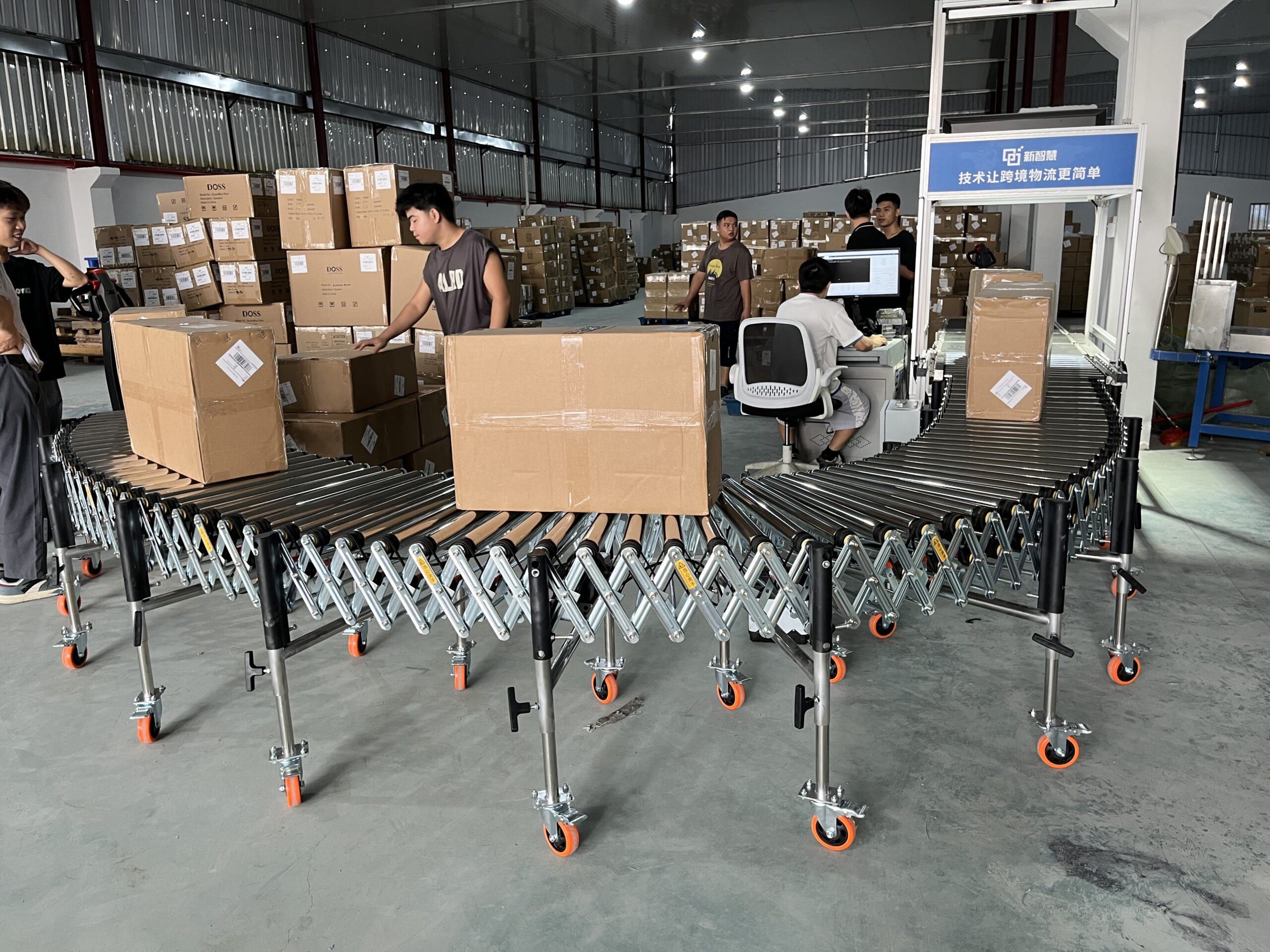
Table of Contents
Recent Posts
Flexible roller conveyors revolutionize material handling through adaptable design features that empower logistics workflows across diverse warehouse settings. These versatile transport solutions offer extendable lengths, adjustable heights, and remarkable mobility thanks to sturdy caster wheels with reliable braking mechanisms.
In this comprehensive guide, we’ll explore the advantages of using different conveyor systems, particularly focusing on powered rubber roller conveyors, hydraulic conveyors, and telescopic conveyors. We’ll also compare these systems and help you make an informed decision based on your specific needs.
This article explores the features, benefits, and practical applications of telescoping conveyors, specifically for loading and unloading cargo, and highlights how these systems can improve your operations.
When setting up a material handling system, many buyers face this critical decision: Should you purchase a single integrated 6-meter powered roller conveyor, or should you buy three separate 2-meter sections that can function independently but also be connected when needed? This seemingly simple choice has significant implications for cost, flexibility, and operational capabilities.
When it comes to selecting conveyors for loading and unloading operations, Skate Wheel Conveyors and Roller Conveyors are two of the most popular options. Both serve similar purposes, yet each type brings unique advantages and features.

